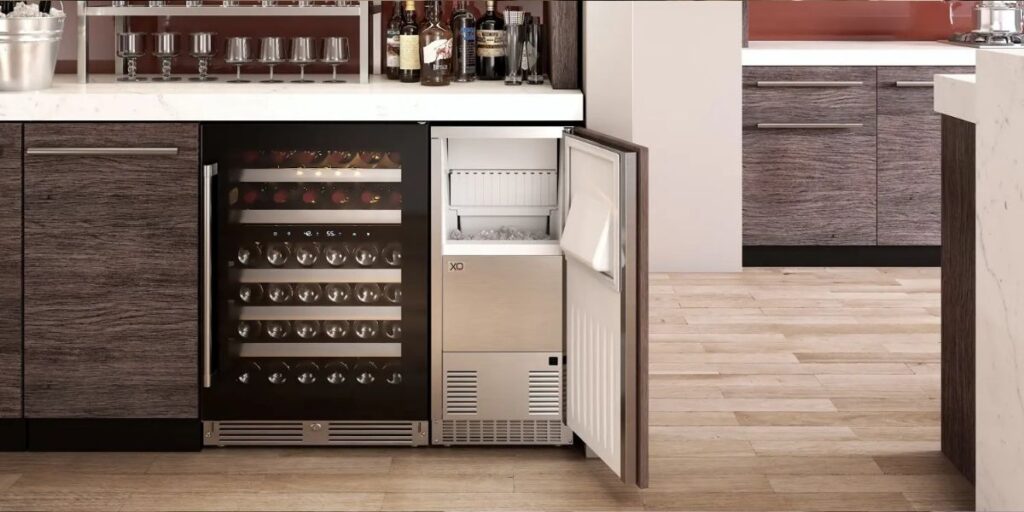Ice machines are crucial in industries like foodservice, hospitality, healthcare, and more. They help keep beverages cold, preserve perishable items, and create the perfect experience for customers. Commercial ice machines come in various types, each suited to specific needs. Among these, undercounter ice machines have gained popularity due to their space-saving design and convenient access. This guide delves into the world of commercial ice machines, focusing on undercounter ice machines, to help you make an informed decision for your business.
1. Understanding Commercial Ice Machines
Commercial ice machines are designed to produce large quantities of ice efficiently. Unlike household ice makers, they are built to endure continuous operation and to meet the high demands of commercial settings. These machines are essential in various establishments, from bustling restaurants to small cafes and even hospitals.
Types of Commercial Ice Machines
Commercial ice machines can be categorized into several types, each offering unique benefits:
- Modular Ice Machines: These large machines are designed solely for ice production. They are typically mounted on top of a separate storage bin, which allows businesses to scale their ice capacity based on demand. They are ideal for high-volume establishments that need a steady supply of ice.
- Self-Contained Ice Machines: Combining ice production and storage in one unit, self-contained machines are ideal for medium-sized businesses. They can be placed in back-of-house settings where space is ample, and they offer the convenience of having everything in one compact package.
- Ice Dispensers: Found mostly in hotels and fast-food restaurants, these machines provide a convenient way for customers to dispense ice directly into their cups. They often include features like water dispensers and are designed for user-friendliness.
- Undercounter Ice Machines: These are specifically designed for smaller spaces, fitting neatly under countertops. They are perfect for bars, cafes, and other areas where space is limited but demand for ice is constant.
2. Types of Ice Produced by Commercial Ice Machines
Commercial ice machines can produce various types of ice, catering to different uses and preferences:
- Cubed Ice: Common in most restaurants and bars, cubed ice is versatile and ideal for both soft drinks and cocktails. It melts slower than other types, keeping drinks cold for longer.
- Flake Ice: Known for its soft and moldable nature, flake ice is popular in food displays, such as seafood or salad bars, and even medical uses. It cools items quickly and is gentle on delicate foods.
- Nugget Ice: Also called chewable ice, nugget ice is popular for cocktails and specialty drinks. Its soft texture and quick chilling properties make it a favorite among customers.
- Gourmet Ice: Often found in upscale restaurants and bars, gourmet ice is crystal-clear, slow-melting, and offers an elegant touch to premium beverages.
3. Key Considerations for Choosing a Commercial Ice Machine
Selecting the right commercial ice machine requires careful evaluation of several factors:
- Capacity Needs: Estimating your daily ice needs is crucial. For example, a busy restaurant may need upwards of 500 pounds of ice daily, while a smaller cafe might require only 100-200 pounds.
- Space and Location: Ensure that you have enough space for the machine, including adequate ventilation if required. Some machines may need additional space for an ice bin.
- Maintenance Requirements: Routine cleaning and maintenance are essential to keep your machine running efficiently. Consider models with self-cleaning features to reduce labor costs.
- Energy Efficiency: Energy-efficient models reduce utility costs and minimize environmental impact. Look for Energy Star-certified machines, which are typically 10-15% more efficient than non-certified models.
- Water Usage: In areas with water restrictions, water-efficient machines can significantly reduce your water bills and contribute to sustainability goals.
4. Introduction to Undercounter Ice Machines
Undercounter ice machines are compact, self-contained units designed to fit beneath counters, providing an efficient solution for establishments with limited space. They are perfect for businesses that need a steady supply of ice within easy reach, such as bars, cafes, and break rooms.
5. Advantages of Undercounter Ice Machines
Undercounter ice machines come with several benefits:
- Space Efficiency: Their compact design allows them to be tucked under counters, saving valuable floor space in busy environments.
- Convenience and Accessibility: These machines offer quick and easy access to ice, making them ideal for customer-facing roles like bartenders and baristas who need ice on demand.
- Versatility: Undercounter models are versatile and can be installed in kitchens, bar areas, outdoor patios, and other locations. Their compact size makes them easy to integrate into various settings.
- Energy and Water Efficiency: Undercounter machines generally have smaller production capacities, meaning they consume less energy and water than larger models. This makes them a good option for businesses looking to reduce operating costs.
6. Considerations When Buying an Undercounter Ice Machine
When selecting an undercounter ice machine, consider the following factors:
- Production Capacity and Storage: Make sure the machine’s production capacity aligns with your daily ice requirements. Some undercounter machines can produce 50 pounds of ice per day, while others can make over 100 pounds.
- Size and Installation Requirements: Measure your space to ensure the machine fits comfortably. Consider access to power and water lines and ensure ventilation if necessary.
- Type of Ice Needed: Different machines produce different ice types. Choose one that produces the type most suited to your establishment’s needs.
- Noise Levels: Since undercounter machines are often placed in customer-facing areas, consider their noise output to avoid disturbances.
- Maintenance and Cleaning: Frequent maintenance is essential for all ice machines. Some undercounter models offer self-cleaning features that reduce upkeep effort.
7. Maintenance Tips for Commercial and Undercounter Ice Machines
Proper maintenance is key to the longevity and performance of ice machines. Here are some maintenance tips:
- Regular Cleaning and Sanitization: Clean your machine according to the manufacturer’s instructions, typically every 1-2 weeks, to prevent bacterial buildup.
- Descaling: If your business is in an area with hard water, descaling the machine regularly is crucial to prevent mineral deposits that can clog the machine and reduce efficiency.
- Filter Changes: Regularly change the water filter to ensure ice quality and protect machine components from impurities.
- Professional Servicing: Regularly schedule professional servicing to address any wear and tear and to maintain peak performance.
8. Popular Brands and Models in the Market
Leading brands in the commercial ice machine market include Manitowoc, Hoshizaki, Scotsman, and Ice-O-Matic. Each brand offers a range of models, from high-capacity modular machines to compact undercounter options. When choosing a brand, consider reliability, customer support, and warranty options.
9. Cost and ROI of Commercial Ice Machines
Commercial ice machines can be a significant investment. Initial purchase prices can range from a few hundred to several thousand dollars, depending on capacity and features. Operating costs will include energy, water, and maintenance expenses. However, the return on investment can be substantial, particularly in businesses where ice is essential for operations, as it improves service efficiency and customer satisfaction.
Conclusion
Commercial and undercounter ice machines are vital to the success of many businesses, particularly in the foodservice and hospitality sectors. By selecting the right machine, you can ensure a steady supply of ice, improve customer satisfaction, and manage operating costs effectively. Consider your capacity needs, space limitations, and maintenance capabilities when making a choice, and remember that a well-maintained machine will serve your business for many years.







